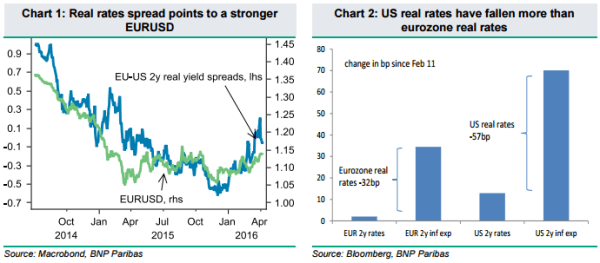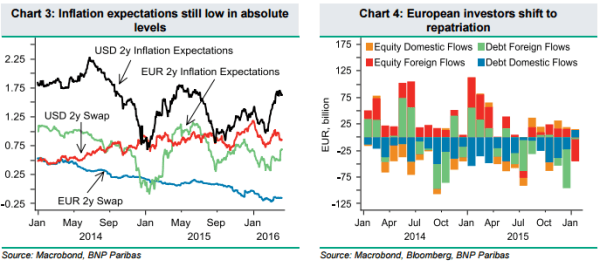Key quotes from the BNPP FX report
EUR/USD Real rates are key
We have long argued that, with a number of major central banks reaching a lower bound for nominal policy rates, real rates should become key for G10 FX. This is because at the lower bound, non-conventional policies increasingly work through inflation expectations. When nominal rates have little room to move, market reaction to central bank policy action should be mainly captured through inflation expectations and their impact on real rates.
Real rates spreads are currently sending a bullish signal for EUR/USD (Chart 1). Drilling into the details of what moved the eurozone-US 2y real rate spread suggests that, while both eurozone and US real rates declined recently, US rates fell by nearly twice as much as eurozone rates. As highlighted in Chart 2, US real rates fell because a 70bp rise in US inflation expectations from mid-February far outpaced the 13bp rise in 2y yields. Meanwhile, eurozone inflation expectations rose by a smaller 35bp and nominal yields were little changed.

In our view, real rate dynamics capture well the market impact of recent central bank policy announcements. Markets went into the March ECB meeting with a rate cut priced in and came out with the perception that the ECB has reached the lower bound for the deposit rate. Subsequently, the eurozone 2y yield is not far from where it was nearly two months ago. At the same time, the ECB still has a hard time raising domestic inflation expectations, which remain stuck below levels that prevailed around the start of the ECB’s quantitative easing programme in 2015, as measured by shorter-term measures such as the 2y inflation swap as well as the longer-term 5y5y measure, which is the ECB’s preferred gauge.
As mentioned above, most of the move in real rate differentials in favour of EUR/USD is actually explained by the US side of the equation. A rebound in risk sentiment, equities and oil prices has triggered a recovery in US inflation expectations since mid-February. However, US front-end yields have been restrained by the Fed’s dovishness, implying a sizeable drop in US real rates. Thus, as long as Fed expectations remain mired at the current very dovish levels, the dollar should struggle to take advantage of either the improvement in global sentiment or the uptick in US inflation.
Inflation expectations and real rates are particularly important for EUR/USD because of their impact on cross border portfolio flows. The eurozone is running a current account surplus of 3.1% of GDP, which needs to be recycled via portfolio and FDI outflows. Portfolio flows have been sensitive to domestic real rates, such that the period where the ECB was most successful in raising expectations, in late 2014 – early 2015, was associated with increased purchases of foreign securities by eurozone investors. Thus, the inability of the ECB to push domestic real rates down much further, combined with a decline in foreign real rates, is probably restraining eurozone portfolio outflows as recent data suggest (Chart 4). This is consistent with a stronger EUR/USD.

Where to from here? Already at a lower bound for policy rates, and with only limited scope to increase the size of its asset purchase programme, the ECB may struggle to push real rates down by much, at least in the near term. At the same time, we don’t believe the risk environment will be positive enough in Q2 to allow the Fed to hike, implying that US front-end yields will remain at current low levels. This should keep EUR/USD gradually rising towards our 1.16 target. In the second half of the year we expect a modest decline in EUR/USD to 1.14, as a better risk environment gradually allows for a more efficient recycling of the eurozone current account surplus.
